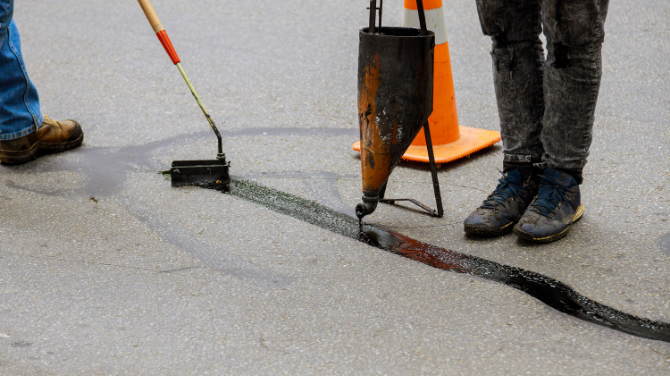Crack seal is a pavement maintenance mainstay. Out of all asphalt services, this simple process can have great impact on the lifespan of your lot. Crack sealing is the technique – whether through a hot sealant, or rubberized sealant that stays flexible to move with the pavement – of closing up cracks to prevent water intrusion. Its benefits are many fold.
Crack seal prolongs the longevity of your lot. The life of your asphalt hinges on asphalt maintenance, so getting an asphalt sealing contractor to combat the cracks is crucial. Asphalt surfaces are compromised by cold weather, extended exposure to UV rays, rain and other elements: asphalt pavement can become brittle and bleached of essential oils over time and begin to crack. When a crack opens up, it is absolutely critical to close it with crack sealants to prevent water from leeching in below the pavement surface. Water is your worst enemy, because it freezes, expands, then thaws and repeats, exacting a toll on your sub base and exponentially worsening existing damage.
For this reason, asphalt repair contractors are adept at quickly repairing cracks, because in fact, cracks can be active and expand over time for greater diameter and damage. When combined with sealcoating, crack sealing can be a life-saving prescription for your asphalt. Asphalt sealing companies can preserve while asphalt contractors can repair and replace – it’s wise to find a company who can expertly do both, like Redwop can.
Crack sealing is the single most cost-effective way to preserve the integrity of your parking lot. The application may not always be pretty, but it’s pretty effective. When a crack forms, allowing it to cause further damage will only drain your resources further in the long run. It’s wise to make the small upfront investment now, to save thousands later. Crack seal can be supplemented with sealcoating product for maximum protection, postponing the need for asphalt paving services and curing within 24 hours. Crack filling also allows you to comply with your line striping: you don’t want any ADA fines on top of other damage.
The best way to keep asphalt in good condition is to address problems as they arise. Don’t leave a small problem to sit, expand, and become a big problem. Once even the smallest crack appears, attack it and repair it. Even seasoned professionals can make mistakes and employ the wrong repairs relative to the problem. Knowing the proper techniques and when to use them will make your business stronger and more profitable. Here we’ll discuss the difference between crack filling and crack sealing so that you can speak in strong, confident language with potential customers.
The Differend between Crack Filling & Crack Sealing.
CRACK FILLING
Crack filling involves using cold-patch or hot-patch asphalt to fill larger, nonworking cracks and holes that sealing won’t fully address. Nonworking cracks are generally less than 0.10 inches wide. This type of crack, which can include block, longitudinal, or diagonal cracks, doesn’t move due to the close spacing between the edges. If the pavement isn’t showing too much movement, then filling is the recommended technique. Deeper and wider cracks also need filling because it’s a more permanent and durable solution.
The filling process uses materials that aren’t rubberized due to minimal flexibility expectations. The crack filling equipment needed is also minimal in comparison to sealing: a shovel, a tamper, pressurized air, and the patch mix are generally enough to fill holes and cracks.
CRACK SEALING
When the cracks are smaller and more manageable, crack sealing is the solution. Even though the process is quicker and for smaller repairs, more equipment is needed for sealing. Crack sealing equipment such as tanks, melt pots, and torches is needed for the job, and depending on your level of skill, you may need more. Sealing involves cleaning out the crack and injecting hot sealant into or above the crack. The purpose is to seal the crack so that water doesn’t get into the crack and the subgrade. When cracks are in their infancy, sealant is used to prevent them from getting larger and becoming bigger problems. The cracks should be shallow and less than three-quarters of an inch wide. Anything larger than that, and the sealer won’t work adequately—filling should be used instead. Sealing is a more expensive process due to the tools and materials needed, but it’s a better value because it has a longer lifespan and protects longer than filling does.
To know more Crack sealing Contact us
+91 9724655551 or Visit: www.redwop.net

